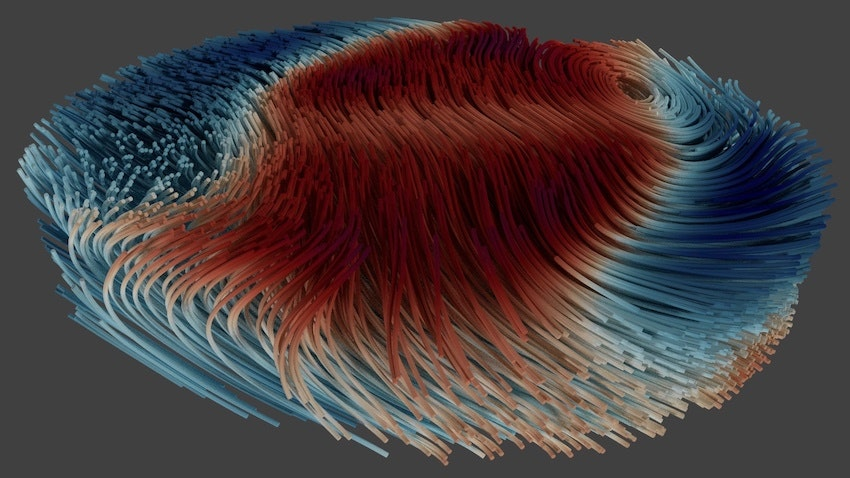
Rendering of a snapshot of the reconstructed 3D magnetic structure. Image Credit: Claire Donnelly
An international team of scientists has established a new method of three-dimensional imaging that can demonstrate the fast-moving waves and ‘tornadoes' within magnets in 3D for the very first time.
This is a significant step forward in the field of technology as it will allow scientists to gain a greater understanding and control of the behaviors of new breeds of magnet, that will be used for data storage and processing devices of the future.
Developing a New Imaging Technique
Researchers from the Universities of Cambridge and Glasgow, based in the UK, and from ETH Zurich and the Paul Scherrer Institute in Switzerland teamed up to develop a new technique for observing the behavior of magnetism in three dimensions. The team published their work this month in the journal Nature Nanotechnology, where they describe how they used their groundbreaking technique to visualize the fast-moving waves and ‘tornadoes’ induced in magnetic fields that measure less than the diameter of a human hair.
Moving from 2-D to 3-D
Magnets are fundamental components in a range of modern technological devices, they are essential in applications from data storage to energy production. However, while they are incredibly vital units of current devices, and those being designed for the future, there remain many questions about the structure of their magnetization and how it interacts with changing currents and magnetic fields.
The British/Swiss team recognized the need to develop a method capable of measuring the nature of magnetic responses in three dimensions. Previously, these behaviors had only been observed in thin films, providing only two-dimensional information. However, while the process of visualizing magnetic behavior in two dimensions is relatively simple, it becomes vastly more complex in three dimensions. In the third dimension, magnetization can direct and create patterns in any orientation, which is what gives magnets their power.
While difficult to image, the scientists recognized the benefits of developing a method to view the patterns and structures created by magnetization in full. It would allow them to understand how they respond to external stimuli, knowledge that is essential in developing advanced magnetic devices.
Overcoming the Challenges of Visualizing Magnetization
As changes in magnetization are characteristically very small and occur in extremely short time frames, they are notoriously difficult to capture. The domain structures of the magnetic measure tens to hundreds of nanometers, which to put into perspective, is thousands of times smaller than the width of a hair. These magnetic configurations tend to react to magnetic fields in billionths of a second.
To overcome this challenge, the research team developed their technique known as time-resolved magnetic laminography using synchrotron X-rays to probe the magnetic state inside a magnet different directions at the nanoscale and determine how it responds to a rapidly alternating magnetic field.
Their method is able to produce data in seven dimensions via a specifically designed reconstruction algorithm, creating a map of magnetization dynamics. The data collected during the study revealed patterns that looked like a nanoscale storm. The team had visualized wave patterns and tornadoes moving inside the magnet, shifting from side to side in response to the alternating magnetic field. This was the first time these tornadoes have been observed in three dimensions.
While conventional magnets were used in the study, the researchers believe that their technique will be vital in the process of developing new kinds of magnets with different magnetic characteristics which will be relied upon for next-generation devices. Researchers envision the technique being utilized in the development of 3-D-printed nanomagnets and new high-efficiency data storage and processing devices. In addition, it is believed that other new applications may be made possible through the use of this technique, those that currently haven't even been thought of.
Disclaimer: The views expressed here are those of the author expressed in their private capacity and do not necessarily represent the views of AZoM.com Limited T/A AZoNetwork the owner and operator of this website. This disclaimer forms part of the Terms and conditions of use of this website.